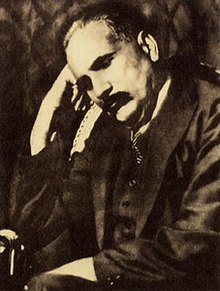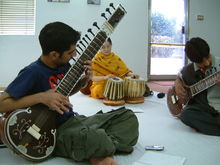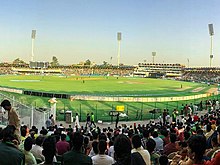Culture of Pakistan
[1] Over centuries, the region has developed a distinct cultural identity, shaped by a fusion of Middle Eastern, Central Asian and North Indian influences.This shift significantly reshaped the historical values and traditions of the country's Muslim population, reinforcing religious conservatism in social and cultural norms.Civil society in Pakistan is largely hierarchical, emphasising local cultural etiquette and traditional Islamic values that govern personal and political life.He was a strong proponent of the political and spiritual revival of Islamic civilisation and encouraged Muslims all over the world to bring about a successful revolution (regarding to the freedom from Colonial powers).Influential work by Manzoor Ahmad, Jaun Elia, Hasan Askari Rizvi, and Abdul Khaliq brought mainstream social, political, and analytical philosophy to the fore in academia.With the beginning of the Indus civilization around the middle of the 3rd millennium BCE,[22] an advanced urban culture developed for the first time in the region, with large buildings, some of which survive to this day.[citation needed] The rise of Buddhism and the influence of Greek civilisation led to the development of a Greco-Buddhist style,[24] starting from the 1st century CE.This shift introduced intricate geometric patterns, arabesques, and calligraphy, replacing the Buddhist emphasis on human and animal depictions, which are generally avoided in Islamic art and architecture.In the British colonial period, predominantly functional buildings of the Indo-European style developed from a mixture of European and Mughal architectural traditions.[39] Pakistani cuisine lies at the crossroads of Central Asian, Middle Eastern, North Indian, and Iranian culinary traditions, with some practices, such as the use of nuts in garnishing, tracing back to the royal kitchens of the 16th-century Mughal emperors.[41][42] The level of spice is typically low in most traditional cuisines, such as those of Pashtun, Balochi, Gilgiti, Balti, Sindhi, and southern and northern Punjab.However, in Central and Eastern Punjab, as well as in the cuisine of the Muhajir community—Indian immigrants primarily settled in Karachi, the country's financial hub—the food is often spicy.[43][44] Traditionally, meals are served on a dastarkhān—a special rug lined with a plastic sheet to prevent spills and surrounded by cushions or pillows for added comfort.[53] In contrast to the ailing Pakistani film industry, Urdu televised dramas and theatrical performances continue to be popular, as many entertainment media outlets air them regularly.[54] Urdu dramas dominate the television entertainment industry, which has launched critically acclaimed miniseries and featured popular actors and actresses since the 1990s.









Truck artHistoryPakistan MovementPeopleList of PakistanisPakistani nameLanguagesLanguages of PakistanfolkloreCuisineMughlaiMuhajirPunjabiSaraikiLahoriSindhiBalochiHazaraPashtunChitraliKalashKashmiriPakistani ChineseFestivalsPublic holidaysReligionMosquesSufismChristianityHinduismSikhismBahá'íAhmadiyyaArchitectureSculptureLiteratureComicsPoetryTheaterTV Dramas & serialsTelevisionCinemaWorld Heritage SitesSymbolsCoat of armsNational anthemromanizedTurko-PersianNorth IndianMiddle EasternCentral Asianethnic groupsIslamization policiesconservative IslamicCivil societylocal cultural etiquetteextended familynuclear familiesshalwar kameezEid-ul-FitrEid-ul-AzhaRamazanChristmasEasterDiwaliA.T. KearneyGlobalization IndexPakistani literatureList of Urdu-language poetsPakistani poetryMuhammad IqbalPersianPashtoEnglishPakistan Academy of LettersNational Libraryreligious poetrymysticalfolkloricliterary realismProse fictionnational poetAllama Muhammad IqbalFaiz Ahmed FaizMirza GhalibAhmed FarazParveen ShakirSaadat Hasan MantoSadequainGulgeeShah Abdul LatifBulleh ShahMian Muhammad BakhshKhawaja FaridMirza Kalich BegSir Syed Ahmad KhanMuhammad AsadMaududiMohammad Ali JoharBritishAmerican philosophyphilosophical developmentM. M. SharifZafar HassanJalaludin Abdur RahimGianchandaniMalik KhalidMarxismManzoor AhmadJaun EliaHasan Askari RizviAbdul Khaliqsocialpoliticalanalytical philosophyNoam ChomskyMusic of PakistanIslamabadPakistani musicQawwaliGhazalFolk dances of PunjabJhumarBalochPashtunsQuetta